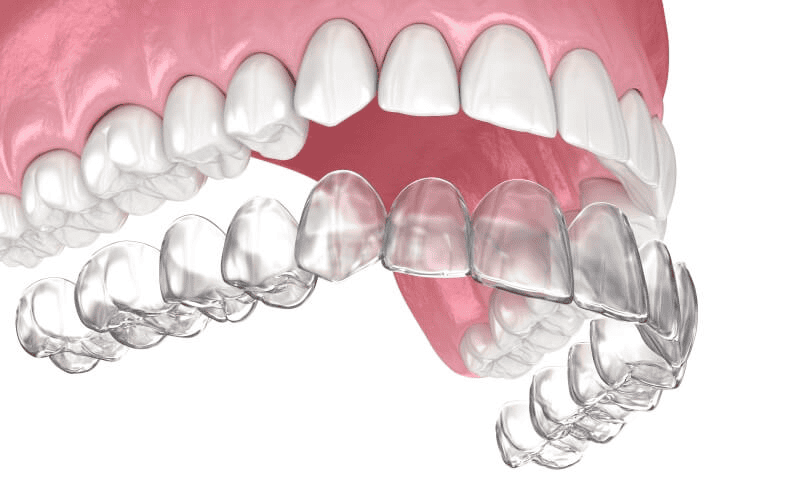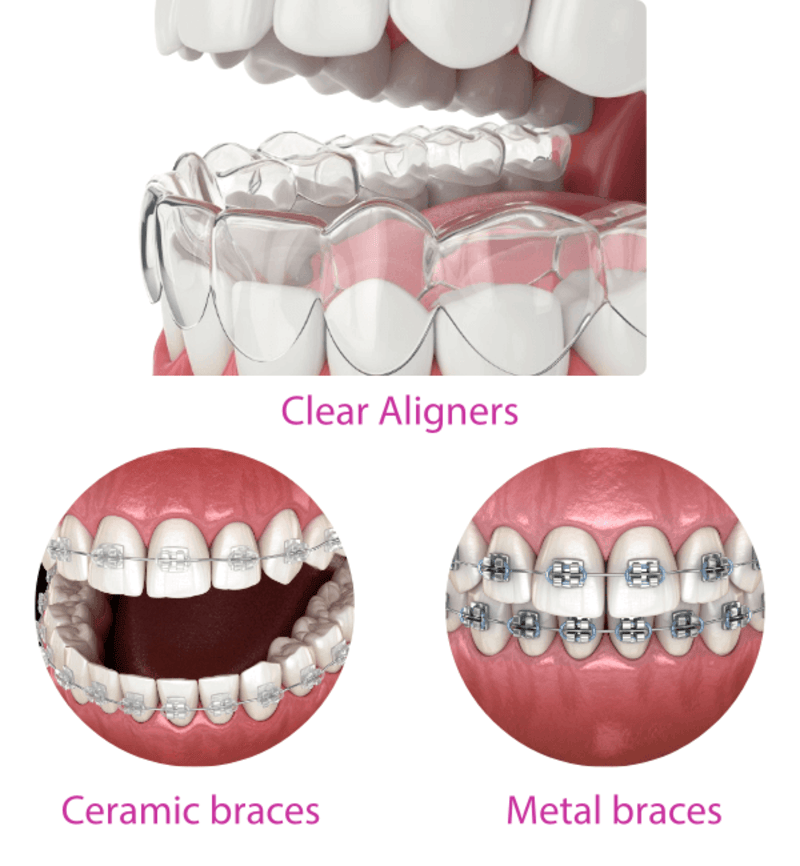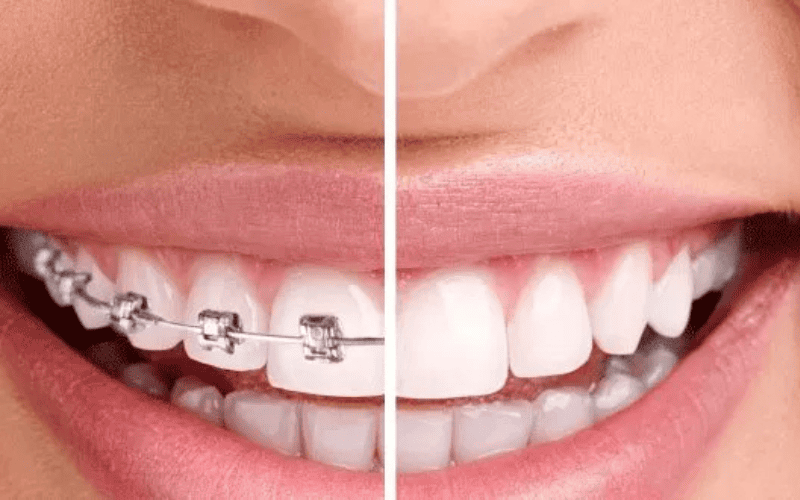Table of content
When comparing orthodontic treatments, understanding the “Invisalign vs braces cost” is crucial for making an informed decision. Both options provide effective solutions for achieving a stunning smile, but they differ significantly in terms of price, appearance, and treatment experience. At Elite Dental, we guide you through these choices, helping you select the best treatment based on your needs and budget.
1. What are Invisalign braces? Advantages of Invisalign braces?
Invisalign and traditional braces offer different approaches to orthodontic treatment. Understanding each option’s benefits is key before comparing costs:
1.1. What are Invisalign braces?
Invisalign is a modern orthodontic treatment that uses a series of clear, removable aligners to gradually straighten teeth. These custom-made, transparent plastic trays are designed using 3D computer imaging technology to shift your teeth into their proper position. Unlike traditional braces, Invisalign aligners are virtually invisible and can be removed for eating, drinking, brushing, and flossing.
1.2 Advantages of Invisalign braces
- Nearly invisible appearance makes them aesthetically pleasing
- Removable for eating, drinking, brushing, and flossing
- Typically more comfortable with no metal brackets or wires to cause irritation
- Fewer dental visits required compared to traditional braces

What are clear braces? Factors to consider before getting started
- No food restrictions since aligners are removed while eating
- Easier to maintain oral hygiene with removable aligners
- Predictable treatment time frame with 3D treatment planning
2. What are braces? Advantages of braces?
Traditional braces have evolved significantly over the years. Understanding how they work and their benefits helps in effectively comparing them with Invisalign:
2.1. What are braces?
Traditional braces consist of metal brackets attached to each tooth, connected by wires and tiny rubber bands. These components work together to apply constant pressure on teeth, gradually moving them into proper alignment. Modern braces have become smaller and less noticeable than those used in the past, with options including ceramic (tooth-colored) brackets and even lingual braces that attach to the back of teeth.

Orthodontic Braces: Types & How do they work?
2.2. Advantages of braces?
- Effective for treating complex orthodontic issues
- Fixed nature ensures consistent treatment (no risk of forgetting to wear)
- Typically more affordable than Invisalign
Orthodontic Braces: Types & How do they work?
- Various options available (metal, ceramic, lingual)
- May achieve results faster for certain conditions
- No temptation to remove, ensuring continuous treatment
- Better control for vertical teeth movement and rotating teeth
3. The brands of clear aligners Elite uses
At Elite Dental, we pride ourselves on providing patients with flexible options through partnerships with many leading clear aligner systems. We partner with renowned brands like Clear Correct, known for their precision engineering and comfortable materials. Our in-house manufacturing capabilities are what really distinguish Elite Dental; we create and produce custom aligners that are suited to the individual tooth structure and treatment objectives of each patient.
This dual approach allows our professionals to choose the optimal solution for each case, whether using established commercial brands or creating bespoke aligners that address specific orthodontic challenges. We have more control over quality, timeliness, and customization thanks to our in-house manufacturing, which may also save our patients money.

What are clear braces? Factors to consider before getting started
Even for complicated orthodontic cases, Elite Dental specialists use their in-depth training in these various systems, utilizing cutting-edge digital treatment planning technologies to produce exceptional results.
4. Compare Invisalign braces with braces
When comparing invisalign vs braces cost, several factors should be considered beyond just price. Let’s explore how these orthodontic options differ across various aspects.
4.1 On cost
Cost is often a decisive factor when choosing between Invisalign and traditional braces:
Invisalign treatment typically costs between $3.000 and $8.000 USD, with an average price of around $5.000 USD, depending on case complexity and location. Some dental insurance plans offer partial coverage, though the coverage amounts can vary.

Compare Invisalign braces with braces
Traditional metal braces generally cost between $1.800 and $5.500 USD, making them more affordable than Invisalign in most cases. Ceramic braces range from $2.000 to $6,500 USD, while lingual braces, which are attached behind the teeth, are the most expensive option, priced between $5.000 and $13.000 USD.
At Elite Dental, we offer comprehensive consultations to help you determine the best option for your orthodontic needs and budget. Our professionals will guide you through the “Invisalign vs braces cost” comparison, assist with insurance coverage, and discuss payment plans to make your chosen treatment more accessible.
4.2 In terms of aesthetics
Both Invisalign and modern braces offer aesthetic advantages depending on your priorities. Invisalign aligners are virtually invisible, making them the clear winner for those concerned about appearance during treatment. However, ceramic braces with tooth-colored brackets provide a relatively discreet option for traditional braces.

Invisalign braces and conventional braces
The best choice depends on your specific situation, including the severity of your orthodontic issues and personal preferences. For professionals who frequently interact with clients or individuals concerned about their appearance during treatment, Invisalign may be preferable. However, those with complex alignment issues might benefit more from traditional braces despite the more noticeable appearance.
4.3 On efficiency
Both Invisalign and traditional braces effectively straighten teeth, but their efficiency can vary depending on the specific orthodontic issues being addressed. Traditional braces typically provide better results for complex cases involving significant bite problems or severely rotated teeth. Invisalign works exceptionally well for mild to moderate alignment issues.

Braces service at Elite Dental
Treatment efficiency ultimately depends on proper diagnosis and oversight by a qualified orthodontist. Regular checkups are essential with either option to ensure treatment progresses as planned. The journey to straight teeth is a gradual process requiring patience and professional guidance regardless of which method you choose.
4.4 On experience
The treatment experience differs significantly between these options:
Invisalign aligners offer greater convenience and comfort. They’re removable, allowing for normal eating and oral hygiene routines. This flexibility makes them particularly suitable for adults with professional and social obligations. However, this advantage requires discipline—aligners must be worn 20-22 hours daily for optimal results.
Traditional braces, while permanently fixed until treatment completion, deliver consistent pressure for tooth movement. They excel at treating complex orthodontic issues but can cause initial discomfort and require dietary restrictions to avoid damaging brackets and wires. While less flexible than Invisalign, their fixed nature eliminates compliance concerns.
Choosing between Invisalign and traditional braces involves considering factors like cost, aesthetics, and efficiency. Invisalign offers a discreet look with flexibility at a higher price, while traditional braces are more affordable, especially for complex cases. At Elite, we provide personalized consultations to help you compare “Invisalign vs braces cost” and recommend the best option for your smile and budget.
